This South Dakota town of 737, located 100 miles away from the closest interstate and 40 miles from the nearest railroad, makes no secret of its optimism.
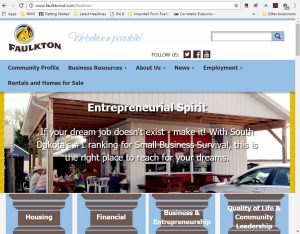
Faulkton’s website includes the slogan “We believe in possible.” Screen capture
“We believe in possible” is Faulkton’s community motto, and it’s plastered all over its marketing—brochures, website, on banners around town, and in the community newspaper.
“We are one community that is not dying that doesn’t have (a major highway or a railroad),” Mayor Slade Roseland said. “People come here” intentionally.
That’s a statement 75 or so businesses are banking on. And, overall, it seems to be working.
“I’ve been in 24 countries across five continents, and I chose here to live,” said Dave Hedt, who moved to Faulkton from Australia to open Walkabout Developments, a strip mall on the eastern edge of town.
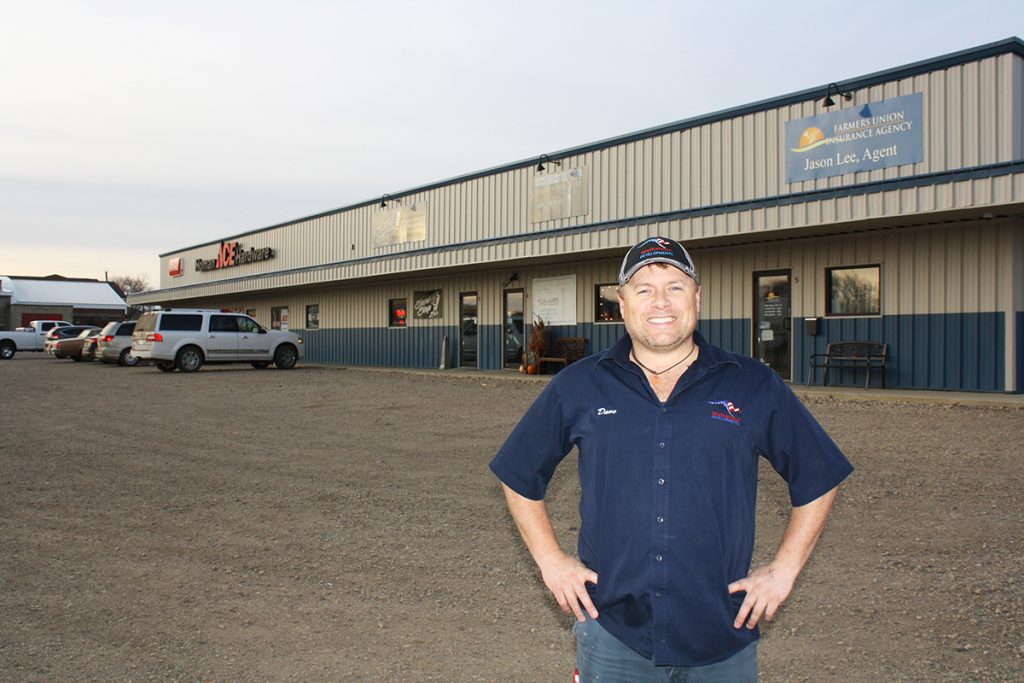
Dave Hedt, formerly of Australia, moved to Faulkton, S.D, in 2013 to open the first of a handful of businesses he owns, operates and/or envisions in the community that has quickly become his forever home. Photo by Wendy Royston
Since he arrived in 2013, Hedt, who was no stranger to entrepreneurship before arriving in the U.S., has opened two other businesses, and he’s on the verge of starting a fourth. Hedt says he has no intention of leaving the community that has mostly embraced him from the start.
“There’s a lot of people who questioned my motives when I moved here and started building a strip mall, because it was so incredibly odd to do that. But, on the flipside, there were so many people who helped me achieve that,” he said. “If you gave me an hour, I couldn’t name all of the people who have done something to help me. … It wasn’t always easy—don’t get me wrong—but everyone saw what I was trying to do, and at least tried to provide some kind of assistance.”
One of those people loaned Hedt the money he needed in 2012 when he was about to give up on his initial project. He was waiting to board a flight back to Australia in the Los Angeles airport when the surprising call came from someone who asked that he never say who it was.
“This person is not who you might think it is,” he said, adding, “that was the first thing that I paid back.”
Trevor Cramer, who himself moved to town just six years ago, said the gesture is not surprising.
There are “people out there who want to help people,” said Cramer, who works as both the executive director of Faulkton Area Economic Development and as Faulk County’s equalization director. “It might come from left field, or it might come from someone you might not think, but they’re out there, and they’re here.”
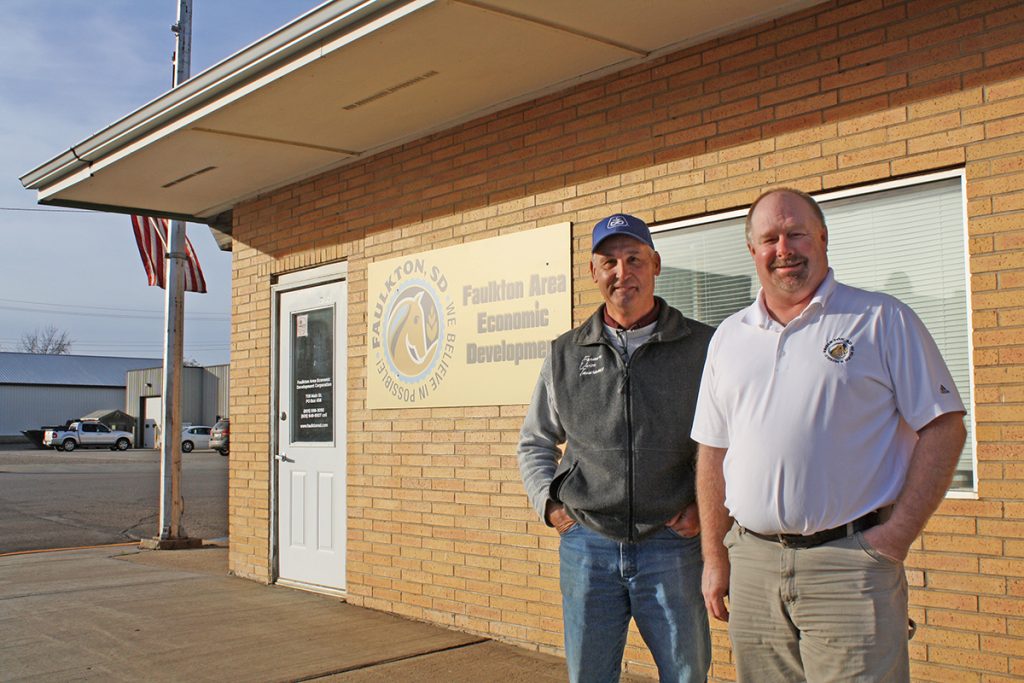
With a population of 737, Faulkton, S.D., is filled with opportunity and possibility, according to Faulkton Area Economic Development President Roger Deiter (left) and Executive Director Trevor Cramer. Photo by Wendy Royston
Finding a home, building a market
When Cramer moved to town in 2010, he forgot to consider one thing: housing.
“If I would have checked (that) out before I moved here … I wouldn’t probably have moved here,” Cramer said. “I took the job, figuring there would be a place to live.”
Cramer, whose wife and four children awaited the end of the school year before they joined him in Faulkton, ended up living in the parsonage of a local church, because the congregation was anticipating being without a pastor until fall. About the time the family unpacked their last box, however, a new pastor was ready to move in, and the Cramers scrambled to find a home in a town with seemingly no housing market.
Through a series of conversations, however, the community discovered an underlying problem: Several Faulkton homes were sitting vacant because families didn’t see the value in selling their grandparents’ homes for $20,000.
With some urging, several houses went on the market.
“Now, things have a value that didn’t have a value before … (and) because those things have (sold), everything has elevated,” Cramer said, adding that some locals have complained a bit about increased valuations increasing taxes, “but you can’t move your community forward by keeping a community down. … We were ranked number two lowest in the state for (housing) costs, and the rest of the top five were on an Indian reservation. That shouldn’t be a badge of honor that your housing costs are that low.”
The community also has made a concerted effort to clean up its housing stock. Eight homes have been either torn down or rehabbed over the past few years. Because of the market movement and community cleanup, lot prices have increased from $500 to as high as $25,000. Five houses were built in 2014, and another is about to go up. As of November, six houses were for sale, seven apartments were available for rent, and the Westside Addition—a development of 24 lots—is in the works.
Several of the purchases were made by younger-generation Faulktonites who knew they wanted to come home, but who thought there was no home to make theirs. In many cases, their new homes were familiar, having previously belonged to the new owners’ own grandparents.
“I just don’t think Faulkton was ready for all of these young people to move back,” said Kayla (Clement) Hanson, who moved with her husband back to Faulkton in 2009, just two years after graduating high school. The Hansons lived with her parents for five months until a small “hunting house” became available. They lived there for three years before they finally found a home large enough for their growing family. “You just make do. It always works out. Everyone always finds a place to live, or someone lets you live somewhere, but I think the housing market is a little better now than it was a couple years ago.”
All roads lead to home
Half of the 23 graduates of the Class of 2007 live in Faulk County. It’s become fairly common that alumni return, bringing spouses and/or children, to build their lives amid the familiarity of their hometown. Roughly one-fourth of all graduates in every class for the past decade have moved back.
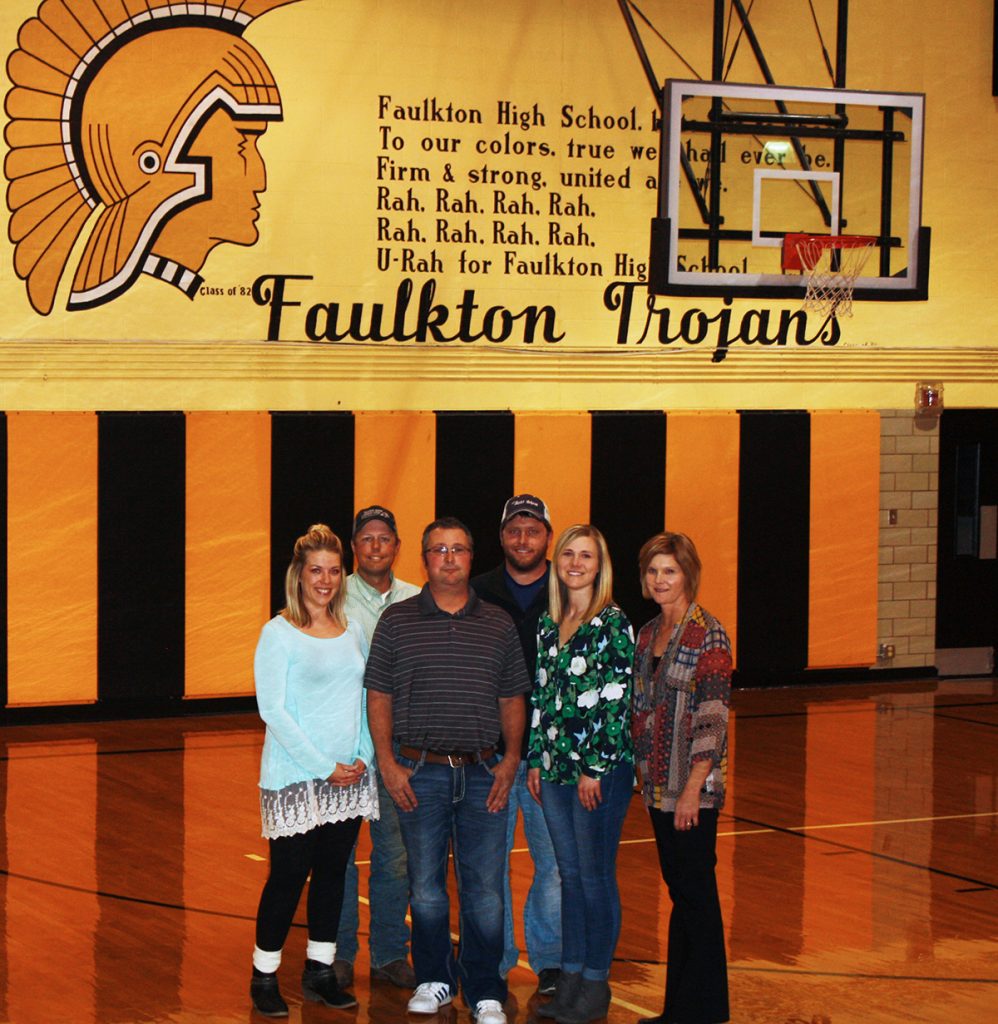
Kayla Hanson (Class of 2007), Troy Hadrick (1994), Slade Roseland (1995), Casey Hlavacek (2004), Megan Hlavacek (2005) and Nikki (Schilder) Melius each moved back to Faulkton, S.D., within a decade of graduating from the local school, and advocate for other alumni to follow their lead. Photo by Wendy Royston
Faulkton’s “returners” said the support of their elders made a difference.
“We weren’t going to move back when we did, but I actually had someone approach me about buying their business,” Hanson said. “I never felt scared ever that I would come and fail,” and she had clients scheduled in her beauty salon the first week she opened.
Things moved even quicker for mechanic Casey Hlavacek, Class of 2004, when he moved home to open The Auto Shop in 2013.
“I had people calling … to get on the schedule” before there was a schedule, he said. “I wasn’t even planning on moving back yet.”
A group of six “returners” laughed that the community gave Hlavacek and others no choice but to move home.
“We’re very supportive of our own,” Roseland said. “We try to do everything to help make it easier for people to move back here.”
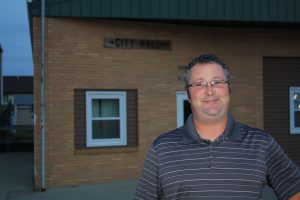
Opportunity can knock louder in small towns than in larger cities, according to Faulkton, S.D., Mayor Slade Roseland, who moved home for a job that offered him a larger salary than similar positions in larger towns, due to his connection to the community.
Photo by Wendy Royston
Roseland moved home to work as an agronomist in 2000, after five years away, because, despite what many might assume, a better opportunity awaited him in Faulkton.
“I could get a starting wage higher in Faulkton than anywhere else,” he said, because “I was a local kid, and they knew I was tied, and there was a better possibility of me not leaving one day. … In that position people tend to disappear” for career advancement elsewhere.
Eventually, he did “leave,” but only to farm his family’s local ground, because “I didn’t want to raise my kids anywhere else,” said Roseland.
“We are traditionally an agricultural community, and that will always be our basis, with where we are geographically, of what our tradition is, of our families and our community,” said Nikki (Schilder) Melius, a 1992 graduate and Faulkton’s family and consumer sciences teacher. “But when you go through the list of (returners), the career clusters are so varied.”
Health care, mechanics, banking and manufacturing are among the careers Faulkton’s youngest adults pursue.
Raising entrepreneurs
The returning young people have changed the town, which now has a veterinarian, mechanics and various other businesses it didn’t have before.
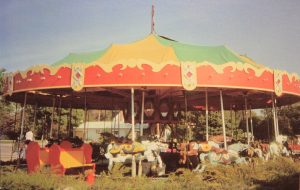
Faulkton, S.D., carousel. Contributed photo
“You try to support those folks, because you know you’re going to need them to be around so you can be successful,” said Troy Hadrick, a 1994 graduate who returned in 2010 and works as a farmer and rancher, plus speaks publicly on ag issues with his wife.
A passion for entrepreneurship is fostered at an early age, when teachers encourage students to think creatively about their futures by exposing them to local individuals whose own career paths are outside of the “norm.” Two years ago, the school hosted an entrepreneurial fair, knowing some students already had their own small businesses.
“We gave them an opportunity to set up some booths and displays and let the community know that (teenagers are) running (their) own businesses,” she said. “With every one of them, there was a person in our community who” said they would mentor the students, or connect them with others who could.
The youths’ businesses range from YouTube channels that help others win video games to family precision farming techniques. One student—Ellen Schlechter—even was awarded a $500 prize in the statewide 2016 Big Idea Contest for her development of The Calving Book, a mobile device application intended to simplify calving, and now sells her app online to farmers and ranchers all over the United States.
The ventures have opened the eyes of more than just the students.
“You think you have to see the storefront” for a business to be legitimate, Nikki Melius said, but “sometimes it takes creativity in a small town to keep things going.”
For the past eight years, the school and community have worked together to bring high school students hands-on work experience through internships.
“All but two (of this year’s 16 seniors) are doing 90 to 240 hours of internship hours,” she said. “Because of those relationships, a lot of our graduates are sought after they have their formal training.”
“I recruit high school students,” said Tom Hericks, director of patient care services at Faulkton Area Medical Center. Students are welcomed to take rotations at the hospital and clinic “to give them something to think about while they’re in school,” he said.

Independent healthcare is at an advantage in today’s insurance-driven markets, according to Faulkton (S.D.) Area Medical Center CEO/Administrator Jay Jahnig and Director of Patient Care Services Tom Hericks. The center is expanding again after previous expansions in 2007 and 2011. Photo by Wendy Royston
Jay Jahnig, CEO/administrator at Faulkton Area Medical Center, said the program has been an asset to the growing facility.
“The best thing that we can do is recruit someone with skills that was from this community … (and) has been working … somewhere else, that wants to come home,” said Jahnig, who is on the development corporation. “We’ve got to capture those talents.”
Employers, teachers and other members of the community have taken a unique step toward staying connected with new graduates by placing letters in mailboxes under their chairs at commencement. The letters encourage the fresh alumni to consider Faulkton after they get their education and experience a bit of the outside world.
The letters are intended to send a message that talents fostered in Faulkton should not be shipped out of town.
“When I was in high school (in Britton), I was told, ‘If you want to make something of yourself, you’ve got to go away,’” Jahnig said. “So, I went away and made something of myself, and was never really given the option to go back home. I’m just one of 1,000 kids that was told that. … You just went off and did your thing.”
“I’ve had several people in their 50s and 60s tell me that when they were growing up—or even when they were my age—and they wanted to come back, they were kind of told, ‘don’t come back. There’s nothing here,’” said Hanson. “I’m not really sure what happened in the community that a switch kind of flipped, but I tell everyone to come back.”
Those students of the 1970s and 1980s, though, know a Faulkton much different than those of the 1990s and 2000s.
“The ’80s killed us,” Kelly Melius said. “I graduated from a class in 1984 with 34 people. … Three or four years after I graduated, the class size dropped to the teens (due to the) ag prices we had back then.”
As in many small towns, as many as one-fourth of farmers left the area.
“Those are families that are gone,” he said. “They aren’t coming back. I think that became a lesson—or an outcry, if you will—to those of us who have always been here and saw that happen and saw how terrible it was and what it did to the school and what it did to a lot of things, and it’s been a constant since then of trying to reverse that trend.”
Progress is being made. Kindergarten projections for the 2018-19 school year are at 29 students—the largest class since the ag crisis nearly 40 years ago—and for the first time in decades, the district may have to split the class into two sections.
Focusing the vision
Faulkton officials credit coaches from Dakota Resources with helping them continue their innovation efforts. Over the course of several community meetings, four key groups—business and entrepreneurship, financial, housing and quality of life—and a whole lot of ideas were born.
“They came along at a time when we needed a little clearer vision of ‘where have we been,’ ‘where is Faulkton at,’ and ‘what do we have to do to be a survivor in the rural community world?’” said Roger Dieter, a Faulkton Area Economic Development board member. “They just really helped us focus on those things (and) get a clearer vision of the future.”
One change was increasing Cramer’s position from part-time to full-time at the beginning of 2016.
“It was the next step to have someone full-time focusing on development,” Dieter said.
“The concepts that this community wanted to do, (we) just couldn’t quite get them over the hump, because it was all volunteers that were doing it, and they all have their own lives and jobs,” Cramer said.
Because of their work with Dakota Resources, the community also made a push for the involvement of younger adults in community planning.
“We made a concerted effort to not just rely on the 50- (to) 60-year-olds who had time to be on the development corporation. We went out and sought ideas (and) opinions from the next generation,” Dieter said. “If we’re going to try to build this community for the future, we need to know what (their) ideas for the future are, not what our ideas are.”
The next step in getting younger people involved—the development of the Business and Professional Group—is underway, and earned Faulkton recognition as the Dakota Resources 2016 Innovative Community of the Year.
Treating the community
A vast “menu” of services has kept Faulkton Area Medical Center not just alive but thriving in a time when many independently owned medical facilities are closing.
Faulk County Memorial Hospital reorganized in 2007 with the construction of a new hospital. Within 18 months, the clinic had generated 385 new medical records for new patients or those who hadn’t been there in at least three years.
“That’s what generated the outpatient center (in 2011)—we build that because we had outgrown our existing space. Now, we’ve pretty much outgrown that existing space and are building on again. We continue to get new patients all of the time.” Hericks said. “It’s kind of exciting to be an independent facility, do your own thing, make your own rules and still be viable.”
Since 2007, FAMC’s gross revenues have doubled twice, and soon will double again.
“We have increased things exponentially, because we are doing things that haven’t traditionally been done in a small town,” Jahnig said.
Hericks said the small town factor is huge for FAMC.
“When you go to a larger institution, the wait time is sometimes labor-intensive. We’re a small town hospital. We have smaller volumes, so if I tell you you have a 10 o’clock appointment for your infusion, you’re probably in a chair at 10:05, not noon or 1,” he said.
Construction of an infusion center that will offer chemotherapy and other specialty treatment options to those who prefer to stay closer to home for those kinds of therapies is underway.
“We deal with a mostly elderly population or Medicare population. Sometimes it’s very difficult for them to (travel a minimum of 60 miles) to get their chemotherapy in or their infusions that are necessary for whatever anomaly that they have. We try to accommodate those patients, so they don’t have to travel so far,” Hericks said.
Remaining independent, though difficult in some ways, offers opportunity not available to larger facilities—especially in a time when medical insurance options in South Dakota are largely limited to those run by the state’s two largest health care systems. While Sanford and Avera health plans are not designed to cover services provided by the opposite system, both cover FAMC as in-network providers. Transfers to the larger facilities for more complex care are “the only limiting factor. … It’s getting to be a bigger and bigger deal,” Hericks said.
Locking up opportunity
Set to open in fall 2017, the Faulk County jail will house as many as 35 inmates. In many ways, the jail is an economic development project.
“Faulk County doesn’t need a jail; Faulk County wants a jail, because everyone else will be bringing their prisoners here, and this will be a revenue source for the county,” Cramer said, adding that the county incarcerates an average of just two offenders monthly.
The nearest jails outside of Faulk County are 45 miles away, and often full.
“There’s actually potential for it to be a profit center,” said Dieter, who also serves as a county commissioner. “If it fills up with out-of-county prisoners, there’s much more profit potential than if we were filling it with our own prisoners.” Closing the jail would have meant the loss of deputy and dispatch jobs, and like any business, “if it leaves town, it’s never coming back, and the old jail just wasn’t feasible to renovate or update it or open it, for liability issues.”
Reimagining ‘workforce’
Though the quantity of workforce in Faulkton is low, “the quality is excellent,” Hedt said, clarifying that “workforce” in Faulkton doesn’t necessarily look like it does elsewhere. “I don’t actually employ anyone,” but instead contract various services with other business owners. “There’s always somebody who knows how to do things (I don’t), and at no stage have I not been able to find that somebody here.”
One partnership is between him and the owner of the local quilting shop, who writes the technical documentation for Hedt’s Walkabout Mother Bins farm trailer business.
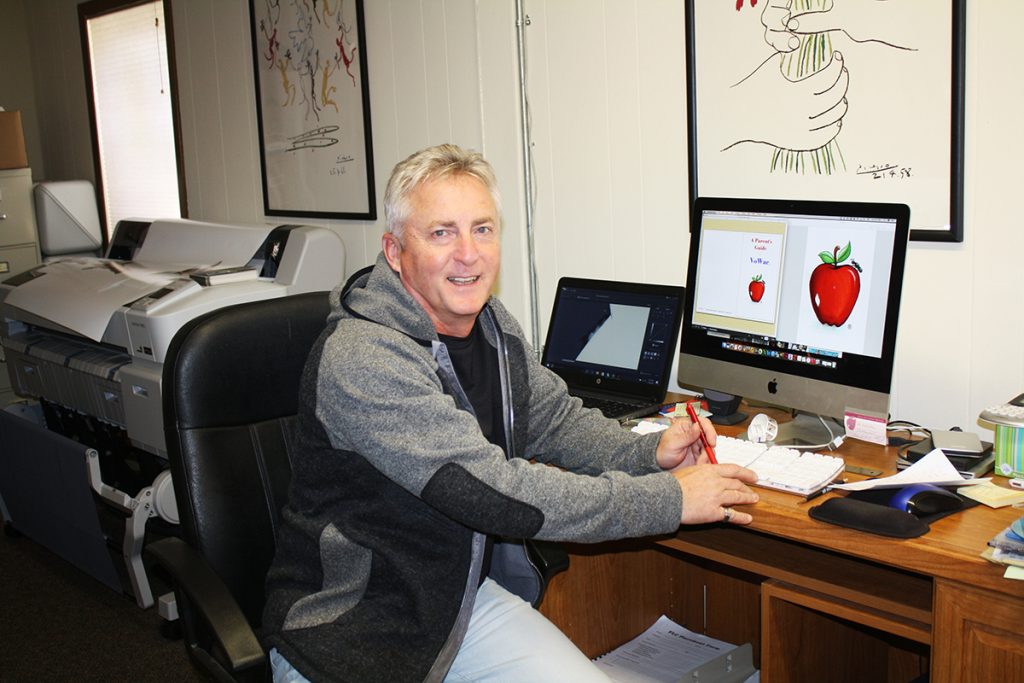
John Pfeifer says the rural nature of Faulkton, S.D., is both an asset and a hindrance in his pursuit of a business partner who eventually could take over ownership of the VoWac Publishing business downtown.
Photo by Wendy Royston
“Faulkton is quite unique, in that the businesses are kind of interdependent upon one another to be successful,” said John Pfeifer, owner of VoWac Publishing, an elementary phonics company based in Faulkton since 1983. “Without the businesses that are here, I definitely wouldn’t be able to do what I am doing.”
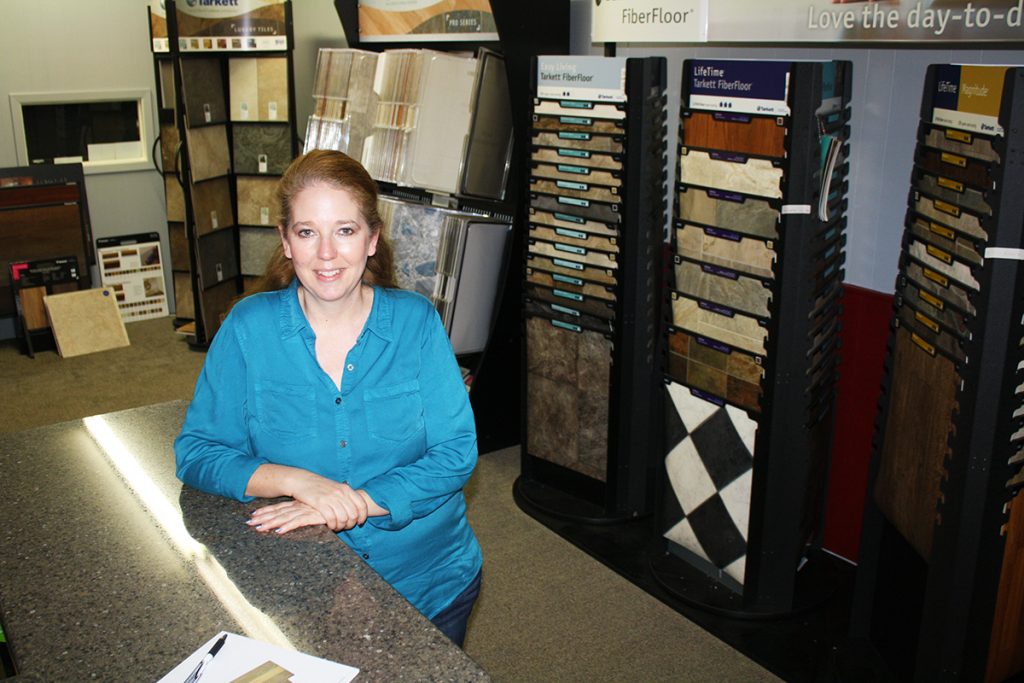
Barb Pearson-Cramer purchased TLC Interiors last year, in an effort to save a business from leaving town when the former owner decided to close up shop. She also operates a North Dakota adoption agency out of Faulkton, S.D. Photo by Wendy Royston
Barb Pearson-Cramer, owner of TLC Interiors—a flooring and window treatment business that she and her husband, Trevor Cramer, purchased last year, to keep the service in town—and a North Dakota adoption agency, said the same is true for her.
“If I need help with something … I have found people … willing to help, to ensure that I’m successful, that these two businesses grow, (and) that we get to the point of hiring people locally,” she said.

Kelly Melius, owner of Common Sense Manufacturing, just outside of Faulkton, S.D., has had to come up with creative ways to overcome workforce shortages. Photo by Wendy Royston
Similarly, Kelly Melius, owner of Common Sense Manufacturing, has addressed his workforce needs creatively. Many of his employees are “bored” retirees who are able to work for periods of time but don’t depend on a steady income. One takes care of his grandchildren before and after school, but works for Common Sense during the day.
“The advantage for us is that … I can fill some gaps in labor that we have, but it is tough,” he said. “There are times that, because we are so flexible and things are tight employee-wise sometimes, that it might take a little bit of time to get a product out, but … it’s what we’ve always done from the very beginning.”
When he began his business in 1998, Melius “leased” employees from a neighbor farmer who didn’t have enough work for his hired men.
“He said, ‘you can have my guys for seven hours a day.’ So we started out literally on a lease agreement,” he said.
The spirit of collaboration is what keeps Faulkton’s business district hopping.
“There’s a lot of support for the businesses that are here. People try their best to shop at home, and not to let their dollars leave here,” Pearson-Cramer said.
Trish Meek’s businesses aim to serve customers in several ways. She has co-owned Muffin Tops, a coffee shop and bakery, and Muffin Bottoms, a gift shop in the lower level of Muffin Tops, with business partner Diane Hepburn since mid-2016.
“I don’t think anybody around here could make a living off just one thing. … You can only eat so many cupcakes and drink so many coffees,” so the shop also offers handmade candies and pastries, as well as daily lunch specials. “We try to have something for everybody, and you pretty much have to do that in a small town.”
Focusing on what her customers need means they return the favor with their business.
“There’s good community support … of any kind of business, because people want this to be a thriving area,” she said.
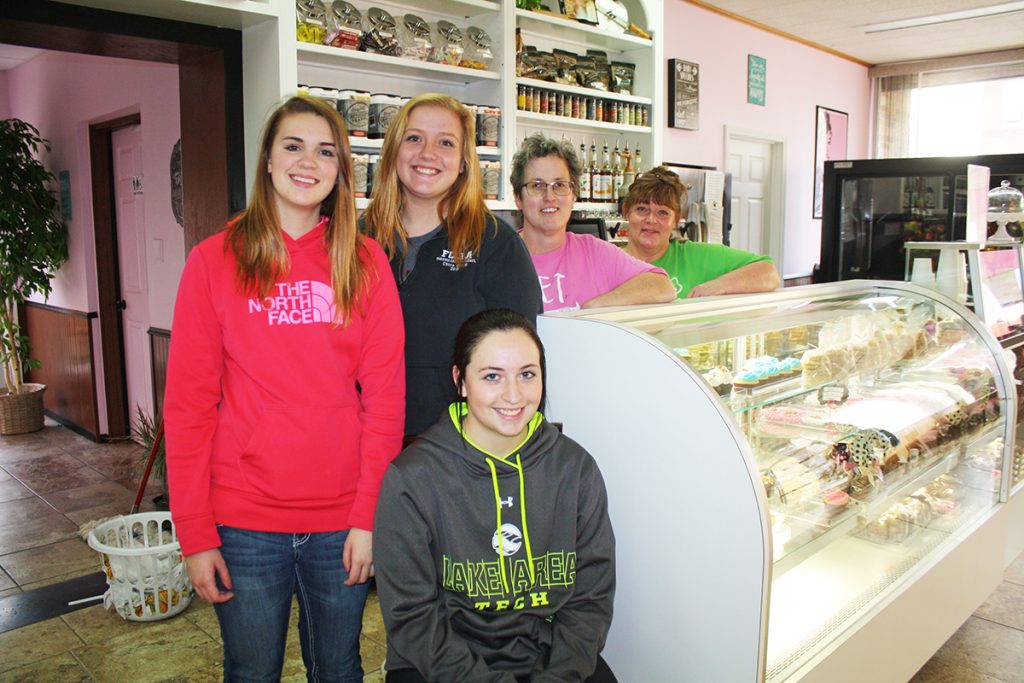
Diane Hepburn (far right) and Trish Meek (second from right), pictured with employees Brandy Melius (in front), Megan Kones (left) and Chloe Brand, say the key to business in a small town is diversity. The duo has sold baked goods, gourmet candies, coffees, and lunch specials at Muffin Tops—and gift items on the lower level Muffin Bottoms—in downtown Faulkton, S.D., since this summer. Photo by Wendy Royston
 Dakotafire Get your spark here.
Dakotafire Get your spark here.



